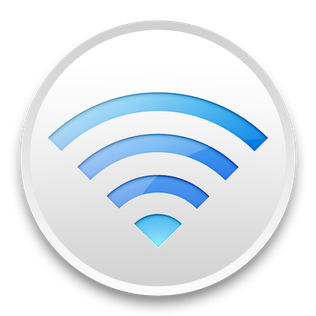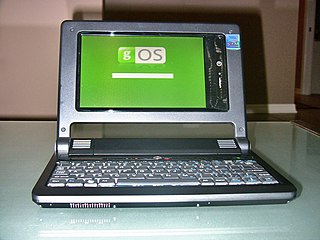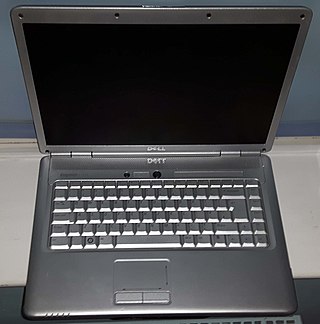
AirPort is a discontinued line of wireless routers and network cards developed by Apple Inc. using Wi-Fi protocols. In Japan, the line of products was marketed under the brand AirMac due to previous registration by I-O Data.

The USB mass storage device class is a set of computing communications protocols, specifically a USB Device Class, defined by the USB Implementers Forum that makes a USB device accessible to a host computing device and enables file transfers between the host and the USB device. To a host, the USB device acts as an external hard drive; the protocol set interfaces with a number of storage devices.

Realtek Semiconductor Corp. is a fabless semiconductor company situated in the Hsinchu Science Park, Hsinchu, Taiwan. Realtek was founded in October 1987 and subsequently listed on the Taiwan Stock Exchange in 1998. Realtek currently manufactures and sells a variety of microchips globally and its product lines broadly fall into three categories: communications network ICs, computer peripheral ICs, and multimedia ICs. As of 2019, Realtek employs 5,000 people, of whom 78% work in research and development.
Parallels Workstation is the first commercial software product released by Parallels, Inc., a developer of desktop and server virtualization software. The Workstation software comprises a virtual machine suite for Intel x86-compatible computers which allows the simultaneous creation and execution of multiple x86 virtual computers. They distributed the product as a download package. Parallels Workstation has been discontinued for Windows and Linux as of 2013.
The Intel Graphics Media Accelerator (GMA) is a series of integrated graphics processors introduced in 2004 by Intel, replacing the earlier Intel Extreme Graphics series and being succeeded by the Intel HD and Iris Graphics series.
Monitor mode, or RFMON mode, allows a computer with a wireless network interface controller (WNIC) to monitor all traffic received on a wireless channel. Unlike promiscuous mode, which is also used for packet sniffing, monitor mode allows packets to be captured without having to associate with an access point or ad hoc network first. Monitor mode only applies to wireless networks, while promiscuous mode can be used on both wired and wireless networks. Monitor mode is one of the eight modes that 802.11 wireless adapter can operate in: Master, Managed, Ad hoc, Repeater, Mesh, Wi-Fi Direct, TDLS and Monitor mode.
Qualcomm Atheros is a developer of semiconductor chips for network communications, particularly wireless chipsets. The company was founded under the name T-Span Systems in 1998 by experts in signal processing and VLSI design from Stanford University, the University of California, Berkeley, and private industry. The company was renamed Atheros Communications in 2000 and it completed an initial public offering in February 2004, trading on the NASDAQ under the symbol ATHR.

The SiS 630 and SiS 730 are a family of highly integrated chipsets for Intel and AMD respectively. At the time of release they were unique in that they not only provided VGA, Audio, LAN, IDE and USB functionality on board, but were also in a single-chip solution. At the time of release (1999) most chipsets were composed of physically separate north-bridge and south-bridge chips. Only later have single-chip solutions become popular in the mainstream, with chipsets such as the nVidia nForce4.

Parallels Desktop for Mac is software providing hardware virtualization for Macintosh computers with Intel processors, and since version 16.5 also for Apple silicon-based Macintosh computers. It is developed by Parallels, since 2018 a subsidiary of Corel.

The NanoBook is an ultra-mobile PC reference design by VIA Technologies, Inc. It has a clamshell form factor, a 7-inch 800×480 touchscreen display, and a full-size keyboard. It weighs less than 850g and has a claimed battery life of up to 4.5 hours. It is based on the VIA VX700 chipset, featuring the VIA UniChrome Pro II IGP integrated graphics and powered by the 1.2-GHz VIA C7-M ultra low voltage processor. It includes up to 1GB DDR2 memory, a minimum 30-GB hard drive, 802.11g WiFi, Bluetooth and Ethernet support, as well as a 4-in-1 card reader, a DVI port and two USB 2.0 ports.
Operating system Wi-Fi support is defined as the facilities an operating system may include for Wi-Fi networking. It usually consists of two pieces of software: device drivers and applications for configuration and management.

The Huawei E220 is a Huawei HSDPA access device (modem) manufactured by Huawei and notable for using the USB interface.

Moblin, short for 'mobile Linux', is a discontinued open source operating system and application stack for Mobile Internet Devices (MIDs), netbooks, nettops and embedded devices.

The BeagleBoard is a low-power open-source single-board computer produced by Texas Instruments in association with Digi-Key and Newark element14. The BeagleBoard was also designed with open source software development in mind, and as a way of demonstrating the Texas Instrument's OMAP3530 system-on-a-chip. The board was developed by a small team of engineers as an educational board that could be used in colleges around the world to teach open source hardware and software capabilities. It is also sold to the public under the Creative Commons share-alike license. The board was designed using Cadence OrCAD for schematics and Cadence Allegro for PCB manufacturing; no simulation software was used.
The Dell Inspiron Mini Series is a line of subnotebook/netbook computers designed by Dell. The series was introduced in September 2008 amidst the growing popularity of low-cost netbook computers introduced by competitors.

The Inspiron 1525 is a laptop designed and distributed by Dell as part of their Inspiron product line. There is also an AMD variant known as the Inspiron 1526. The laptop is the successor to the Inspiron 1520, and was released on January 4, 2008. This computer was available to purchase on the Dell website, where it could be customized to the user's specification.

Tuxera Inc. is a Finnish company that develops and sells file systems, flash management and networking software. The company was founded in 2008 and is headquartered in Espoo, Finland. Tuxera's other offices are located in the US, South Korea, Japan, Hungary, Germany, Taiwan and China.

PicoScope is computer software for real-time signal acquisition of Pico Technology oscilloscopes. PicoScope is supported on Microsoft Windows, Mac OS X, Debian and Ubuntu platforms. PicoScope is primarily used to view and analyze real-time signals from PicoScope oscilloscopes and data loggers. PicoScope software enables analysis using FFT, a spectrum analyser, voltage-based triggers, and the ability to save/load waveforms to disk. PicoScope is compatible with parallel port oscilloscopes and the newer USB oscilloscopes.

Samsung DeX is a feature included on some high-end Samsung handheld devices that enables users to extend their device into a desktop-like experience by connecting a keyboard, mouse, and monitor. The name "DeX" is a contraction of "Desktop eXperience".













